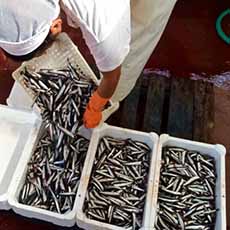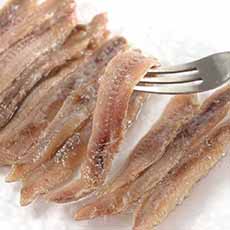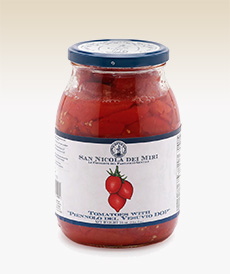PRODUCT: Cetara Anchovies & Anchovy Pasta Recipe
|
Anchovies get a bad rap in the U.S. They typically appear on “most hated foods” lists. That’s because many people were first introduced to cheap, oily, odoriferus, overly salty and “fishy” tasting examples on pizzas or in Caesar salads at the local diner.
One reason those anchovies are so intense is that casual restaurants don’t take the time to rinse the anchovies, but just scoop them up from the oil. Another reason is using cheaper anchovies! But in fact, these little fish can be truly delightful—still with a strong flavor, but one that’s delicious. The 144 species of anchovies, a salt-water fish related to herring. They live in many of the world’s oceans and seas, including the Atlantic, Indian, Mediterranean and Pacific. The good brands are things of beauty. Italians—who not only make some of the world’s best food, but as a society have among the most demanding palates—use them as a backbone in many recipes. The best Italian anchovies come from Cetara (photo #1), an enchanting fishing village along the Amalfi coast, on the Gulf of Salerno. They are packaged by Nettuno, a family-run company. Production is completely by hand, using simple but precise traditions of local anchovy preserving. The best anchovies are caught between March and July when their flesh is at its most plump; the better brands only fish during this period. The fresh anchovies are immediately placed in oak barrels layered with water and sea salt and cured for about five months. The salt used by Nettuno is the exceptional sea salt that is hand-harvested in the salt panes of Trapani, Italy—uncontaminated Sicilian waters. The result: anchovies that are soft, moist, and plump. It takes only a few seconds to rinse them in cold water and then put them to use. Look for Cento, Nettuno and Agostino Recca sardines. And if you’re a true anchovy lover, try a bottle of colatura, “anchovy juice” that is the modern version of garum, the favorite condiment in ancient Rome. You can buy it here. Here’s more about garum, a great umami flavor. This recipe is courtesy of La Cucina Italiana and Chef Andrea Tiberi. Ingredients for 4 Servings 1. HEAT the oven to 200°F. Line a baking sheet with parchment paper. 2. BRING a large saucepan of salted water to a boil. Drop plum tomatoes into water and boil for 30 seconds. Using a slotted spoon, remove tomatoes from the pot (reserve the cooking water). Drain, peel, cut in half, and seed. |
|
|
|
3. PLACE the tomatoes on a baking sheet and sprinkle with salt. Bake until tomatoes are partially dried and flavor is concentrated, about 3 hours. 4. RETURN water to boil. Add pasta and cook until al dente. Drain, transfer to a large bowl, and toss with a drizzle of oil and a pinch of salt. Set aside to cool. 5. REMOVE the tomatoes from the oven; transfer to a cutting board and finely chop. Add to the bowl with the pasta. 6. ADD the the greens, Piennolo tomatoes, 3 tablespoons oil, anchovies, capers, chervil, and marjoram; toss to combine. Arrange on plates. Sprinkle with a pinch of sea salt and some fresh ground pepper. *The Vesuvio Piennolo cherry tomato is a variety grown in the southern Italian region of Campania, around Mount Vesuvius. They owe their intense flavor to the mineral-rich volcanic soil. These small, sweet tomatoes have a certified origin (DOP): Pomodorino del Piennolo del Vesuvio DOP. A regional specialty, they hang in clusters outside homes in the Sorrento peninsula in early fall and are preserved in water for pure taste. For a delicious sauce, simply cook down the tomatoes in their juices over high heat for 4-5 minutes and serve them over pasta. They are available jarred in the U.S. (you can find them on Amazon and elsewhere). CHECK OUT WHAT’S HAPPENING ON OUR HOME PAGE, THENIBBLE.COM. |
||






